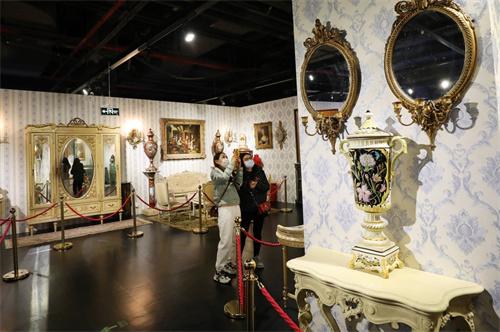
Visitors admire French traditional furniture during an exhibition in Shanghai, east China, March 12, 2021. A China itinerant exhibition of Versailles Palace is held at Xintiandi commercial complex in Shanghai, during which digital technologies and interactive activities offer people the unique experience of visiting the palace. (Xinhua/Fang Zhe)
"We are very proud of it because that means we are two countries of very old culture and the exchange of culture has been very important since the early beginning of the Versailles Palace with King Louis XIV when he decided to send people to discover China," said Catherine Pegard, president of the Versailles Palace.
TOKYO, Sept. 28 (Xinhua) -- An exhibition about historic ties between China and France to be held early next year by the Versailles Palace and the Forbidden City will contribute to mutual understanding and friendship, Catherine Pegard, president of the Versailles Palace has told Xinhua.
"When you exchange masterpieces, when you talk about style, when you talk about art, it is a way to be closer to each other," Pegard said in an exclusive interview with Xinhua on Tuesday at Ginza in central western Tokyo, where she was attending a photo show about the Versailles Palace.
At the Forbidden City, also known as the Palace Museum, in China's capital Beijing, the exhibition entitled "The Palace of Versailles and the Forbidden City: French-Chinese Relations in the 18th Century" will run from April 1 to June 30, 2024, which marks the 60th anniversary of the establishment of diplomatic relations between the two countries.
"We are very proud of it because that means we are two countries of very old culture and the exchange of culture has been very important since the early beginning of the Versailles Palace with King Louis XIV when he decided to send people to discover China," Pegard said.
In 1685, French Jesuits were dispatched by King Louis XIV to China to serve at the Chinese court as mathematicians to the Chinese Emperor Kangxi of the Qing Dynasty (1644-1911), and they were followed by many more serving the Chinese court for a long time, according to the Versailles Palace chair.
Bilateral communication then was not only about culture or arts, it was also about astronomy, mathematics, philosophy, medicine among other areas, Pegard noted, adding "I think it was very far to ever explore each country... It was a sort of mutual curiosity between the two courts. And even with many many differences they wanted to know each other better and I think it was very important for them."
According to Pegard, the Versailles Palace will present masterpieces showing the influence of Chinese style on France and on the court at Versailles, for example, Chinese porcelain, pieces of furniture and some paintings.
"I think it would be attractive for Chinese people to understand how China could influence France at that time," she said, citing the example of Queen Marie Leszczynska, wife of King Louis XV, who was so keen on Chinese style that she used to have her own portrait painted by artists in Chinese style.
Another highlight of the exhibition, Pegard said, is that the viewers will be able to see pieces from the Chinese collections shown for the first time in the Forbidden City.
"Our colleagues of the Forbidden City want to present some presents given by French kings to Chinese emperors," which will mark their debut to the public, she said.
"Please visit this exhibition and then come and see the real Versailles Palace in France," Pegard noted.
Recalling her night tour at the Forbidden City together with French President Emmanuel Macron last April, Pegard said that she was impressed by the immense scale of the palace as well as the marvel of the night view, noting the exhibition next year will be attractive and successful.
